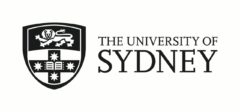When I began volunteering at the Australian Museum, I knew very little about what actually happened behind the scenes of a museum. With a background in biology, archaeology, and history, I began putting these skills to good use by helping out in the Australian Archaeological Collections department. For a few weeks I was anxious about what my project could be. How could I help an organisation as large and as organised as the Australian Museum? It was through the help of the readings and discussions completed in this course ‘History Beyond the Classroom’ that I fully realised the importance of the work I was already completing at the museum. This included preparing archaeological material collected by McBryde for registration, including labelling, sorting, and repacking Australian archaeological material to museum standards, and also creating data sheets for these objects. The more work I did on these tasks, the more I began to realise that they were an important form of archiving. They are crucial behind the scenes tasks that are essential for the preservation of these artefacts for future research or the potential future display of these artefacts in the museum galleries. However I began to worry that this project would not be enough to count as a major project, as the work I was doing was so different to the projects of my classmates. This could include oral histories, brochures, and websites. Instead, I decided to help with various smaller projects at the museum in the hope that it would then be sufficient. These other tasks included organising and creating a data sheet for another archaeological collection at Chowder Bay in NSW, and the still continuing project of creating labels, re-bagging, and photographing artefacts from another McBryde archaeological collection. Furthermore, I was also made aware that the First Nations Cultural Program had some projects that needed to be complete.
Whilst my work in the archaeological collections is by no means original, as every artefact and material that is collected by or donated to a museum undergoes a similar process, it is significant work. However, in a way this specific project is original in that each artefact I have worked on is unique. Furthermore, Professor Isabel McBryde recently donated the collection I was working on to the museum from her archaeological excavations across New South Wales (NSW) and Interstate. Professor McBryde has been described as one of the founders of the discipline of Archaeology in Australia, with a career spanning over 40 years. Particularly, the artefacts I worked on were from a site called Graman in NSW and contained faunal material such as bones, teeth, shells, and much to my surprise, also animal droppings. After the McBryde project, I then worked on the projects of organising and creating a data sheet for artefacts from Chowder Bay and also photographing artefacts from another McBryde site. Whilst completing these projects, I had previously hoped that I would be able to use more of my history skills. Luckily for me, I was then able use more of these skills when helping the First Nations Cultural Program.
I have only started helping in the First Nations Cultural Program more recently, and as such I have completed fewer projects with one in particular still ongoing. These projects included a ‘2020 contact list’, bread and portable oven research, and the ongoing adornment web-project. The 2020 contact list is an excel spread sheet of a contact list for this team, as I believe they will be organising an exhibition in 2020 for the 250th anniversary of the Australian Museum, and as such they need to be able to reach out to other organisations and people. Next, I learnt that this team is also in the development stage of a workshop. During this workshop, they hope to teach visitors about Indigenous agriculture and fishing techniques and processes. It will also examine how these processes have changed present day methods and how the future of this industry may change. As part of this workshop, they hope that the visitors will be able to grind their own flour from native seeds and bake bread made from this flour. In order to help with the development of this workshop, I was tasked with seeing if there was a recipe for Indigenous Australian bread made with kangaroo grass flour. Furthermore, I was to help make a list of a few portable ovens with prices, customer reviews, and specifications. Whilst this task seems simple, it was actually very difficult trying to find recipes online with no success. I did however manage to find bakeries and recipe books that focused on using native plants, seeds, and ingredients, which would hopefully direct later research in the right direction. Finally, I have recently started working on a web project based on First Nations body adornment objects from across Australia. Due to the nature of this particular project, I have primarily been using the primary sources of the adornment objects in the museum collection and any notes written by previous museum staff about each object. I will probably also be drawing on secondary sources, which will help me to understand and write about the significance of a particular adornment object to the culture and history of a person or particular tribe. When each article for a particular object or a group of objects is complete, it will then be posted onto the Australian Museum website for their new page on adornment objects. A shorter version of these articles will also be posted onto the museums social media websites to attract a wider audience and to give the public a snippet of more information that could be found on their website. As such a large and well-established organisation, I believe that these methods will hopefully attract a larger audience than I would be able to reach and to communicate the significance of adornment in First Nation cultures. Furthermore, this web project will be an online resource for educational groups on Aboriginal artefacts within the museum. Whilst I am still currently working on this project, I will be more than happy to do so even after this unit of study ends.
The Maccabean Hall: What lay amid the art deco walls
Prior to volunteering at the Sydney Jewish Museum in Darlinghurst, I had visited the museum quite a few times not knowing about the building’s history and significance. Prior the creation of the Sydney Jewish Museum in 1992, it was a Jewish community centre called the Maccabean Hall, or known as “the Macc”. The Macc opened in 1923 mainly as a Jewish war memorial to commemorate all the Jewish soldiers who served in the Australian Army, as well as a space where the Jewish community could gather to ignite social, cultural, and religious practices. As the years went on, with the increasing immigration of European Jews to escape the antisemitism especially fuelled by the Nazi regime, the Macc became a centre for welcoming these immigrants. English classes, skills lessons, the Jewish Welfare Society, social dances, cultural and religious events were housed under the ceilings of the Macc to ensure the integration of the Jewish community in Australian society, as well as safeguarding the continuation of the Jewish culture. Therefore, this project to tell the story of the Maccabean Hall is important to preserve its narrative and memories from individuals themselves. Such as Jack Meister who went to the Sunday dance, or Peter Wagner’s family who relied on the Sheltered workshops inside the Macc. These are the stories and memories that will not be forgotten, which is why I have created a booklet on the Maccabean Hall for the Sydney Jewish Museum to display for all its visitors.
As we all know, museums can get very busy with the amount of people that walk through the doors everyday, especially since the Sydney Jewish Museum has a very highly regarded education program for students. Once I sat down with the Education Officer, Breann Fallon, I found out that there was one project that the museum desired to add, however, they have not had the time to do so. It was a project on the Maccabean Hall that the museum wanted to implement in some way in order for every visitor to have the opportunity to understand the space they are in. The Sydney Jewish Museum itself documents the history of the Jews all around the world, with their central focus on the Holocaust, via the medium of artefacts, journals, photographs, and most importantly the survivors themselves. This is all housed among the art deco ceilings of the Macc, which had stood as a centre where Holocaust survivors, who have told and still tell their story at the museum, could restart their life in Australia. This has been the purpose of the project, to ensure that every history is not forgotten, even though the building serves a different purpose now, it is important to ensure the survival of its history. Just as the Macc was a community centre and a point of help, the museum serves the same purpose today to bring together various stories in order for them to be retold to a wider audience.
The process of gathering information on the Maccabean Hall brought an abundance of sources. From the interviews I conducted, to the Australian Jewish Historical Society’s archives. What was the significance of the Maccabean Hall? Is it still significant today? Did the purpose of the Macc change overtime? What should be the sequence of the booklet? How will I present the information in the booklet? I started with these questions when conducting all my interviews and searching through several documents, as it lead me to pose many more interesting questions to produce the booklet.
The way the booklet is set out is to tell a story of the Macc through a unique experience. I wanted to highlight some interesting points on the outside and inside of the museum, which may have gone unnoticed. We start the visitor from the outside of the museum, focusing on the stained glass windows, the menorah on the façade, as well as the Gay and Lesbian Holocaust Memorial. I will admit, even I hadn’t noticed these features until they were pointed out to me, which is why I wish to help the museum do the same fro every visitor. Moreover, there are inside features such as the Jewish War Memorial, a mysterious mosaic, a relief, the Children’s Memorial, and the architectural design of the staircase. Furthermore, I conducted three interviews with Peter Wagner, Jack Meister and Mary Ziegler to coincide with the features highlighted as their stories add a personal experience to why we have focused on these areas of the Macc. Both Peter and Jack were part of the Macc community when they arrived in Australia from Europe, rewinding several decades to recount the dances and events they used to attend at the Macc. The image that Peter and Jack described to me is exactly what we wanted to convey to the visitor upon following the map to each feature, and it also was central when deciding what the sequence of the booklet would be. We decided to start with an information page of the Macc, then go into the outside features, followed by Peter’s story. This was so the visitor could walk in the steps of Peter as he would when entering the Macc, especially sine he had been part of the Hall from 1952 to this day.
At the start of this project when I had a clear idea of what history I was telling and in what way, I believed my purpose in this project was to preserve the history of the Maccabean Hall, from its physical features to the recollections from many people part of the Macc community. Especially the memories from individuals like Jack Meister and Peter Wagner, are never forgotten, and continue to be retold amid the art deco walls of the Maccabean Hall.
Who Do You Think You Are – Exploring Students’ Pacific Island History
On Tuesday, seventeen boys of Pacific Island heritage made their way to the campus from Granville Boys High School. The Social Inclusion program hosted a “Who Do You Think You Are” event, facilitating the boys in exploring their personal cultural histories.
The day involved presentations from a number of experts on different pacific island histories. Jude Philp from the Macleay Museum facilitated the day. Writer Jo Kamira spoke about her Maori history and family treasures with the boys. There was a talk by James Flexner on archaeology, oral traditions and written histories, as well as a talk on the history of migration by Matt Poll.
The boys enjoyed lunch out in the sunshine, and the afternoon comprised of a visit to the Nicholson museum to view the Pacific treasures. Finally, we rounded out the day with the boys interviewing one another to find out about their own histories and their family’s migration to Australia. The boys asked each other questions like “Are their any treasures that have been passed down through your family?” and “When did your family migrate to Australia and why?”. A few students presented their stories to the group, making the boys feel a bit like celebrities.
Alongside getting to share their stories, the boys were exposed to a talk by Edie Griffin about her experience as an undergrad students at the university, and options for affordable housing (STUCCO Student Housing Co-op at Sydney).
Best of all, the students were looking through the undergraduate degree guides and discussing options for their own tertiary education on the train ride home.
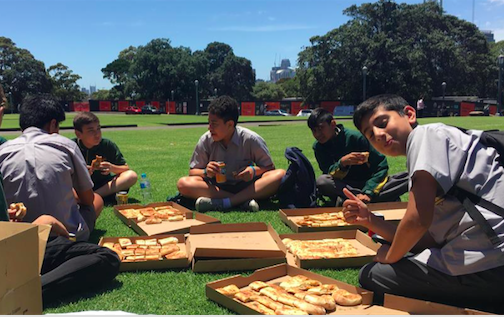
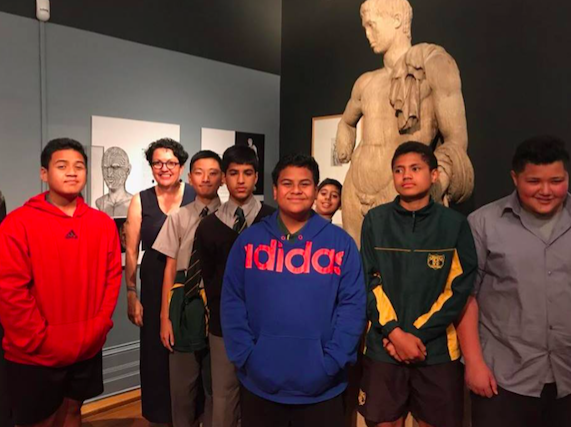
Historical Significance Reports for Items Donated to the Griffith Pioneer Park Museum
I didn’t realise how valuable the opportunity to reflect on this experience would be until I overcame the past few chaotic weeks leading up to the final submission of this project. While it has been far more pressure than I expected, I am truly appreciative of what I have learnt about Griffith and the importance of preserving local Australian history more generally as well as the historical skills I have developed as a result of conducting my own oral histories. I feel that my emotional engagement with the ethics of historical practice is greater as a result and that putting my academic skills to the test has made them far more suitable for various educational and historical functions beyond the university landscape.
My work with Bonnie and the Griffith Pioneer Park Museum has reminded me not only of my passion for curation but also of how important it is to preserve our local history. The site is responsible for preserving the agricultural, social and cultural heritage of Griffith and the surrounding Riverina region, an area I have come to realise through the process of interviewing for this project goes far beyond my knowledge of my own ancestral history in the town. While I was drawn to the organisation due to my personal connection to Griffith, it wasn’t until I read Beth Gibbings’ piece on SIEV X that I realised that it is possible to advocate for the significance of a historical place, event or object without being directly connected to it. While I agree with this, I do also feel that my connection to Griffith made my connection to the interviewees more natural.
I feel a great deal of responsibility knowing that Bonnie is relying on the quality of my academic skills to provide accurate information regarding three collections which have been recently donated to the museum: a cement mixer, optical equipment and telephone exchange equipment. I have worked hard and hope that the reports I have compiled are a reflection of this.
Bonnie’s obvious passion for history and its preservation has been inspiring over this semester. More than anything, I was appreciative of the opportunity to collaborate with someone who is a recent history graduate. Her drive to contribute her time and knowledge wholeheartedly to Pioneer Park has given me the confidence to pursue a career in a field where permanent jobs are often hard to come by, something that has previously intimidated me. While I came into this project being fairly inexperienced in the practice of oral history and interviewing, I am glad that I have pushed myself out of my comfort zone and believe that I have strengthened these skills as a result.
Riding For the Disabled (NSW)
For my project, I have been working with Riding for the Disabled (NSW), a not-for-profit organisation that provides people of all ages and varying disabilities, with the opportunity to ride and interact with horses. When we were asked to approach a community organisation, I immediately thought of Riding for the Disabled (RDA). As a member of the equestrian community in the Southern Highlands, the work that RDA does is very close to my heart and I have attended fundraising gymkhanas to support the organisation since I was four years old. I have been working with Riding for the Disabled (NSW) in a fundraising capacity however due to confidentiality considerations, I am unable to go into more detail about the specific nature of my project. So for this blog, I thought I would include an article I wrote about Riding for the Disabled, Moss Vale. I hope that through my work, I have contributed to the well-being of the Riding for the Disabled community. This unit and more specifically this project, has broadened my perspective on the nature of history significantly. Perhaps most importantly, it has opened my eyes to the dire need for the most vulnerable members of society to have their voices heard by the broader public.
RIDING FOR THE DISABLED- A CLOSER LOOK
By Mary Bokey
Last Wednesday I had the privilege of visiting the Fitzroy Equestrian Center to meet the members of Riding for the Disabled, Moss Vale. Riding for the Disabled (RDA) is a not-for-profit organisation, which gives people of all ages, with various disabilities, the opportunity to ride and interact with horses. It is a nationwide organisation split into state and local branches, and it provides vital physical and psychological therapy for its members.
Angus and Neatie Malcolm have been involved with Riding for the Disabled for over 40 years, and their hard work and dedication has positively influenced the lives of hundreds of people in the Southern Highlands community.
I arrived at the equestrian center to find Angus and a group of volunteers catching the ponies from the paddocks and saddling them up. A mix of men and women, young and ‘slightly older’, all the volunteers were friendly, cheerful and looking forward to a fun morning of riding.
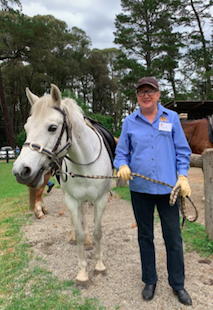
Pictured above: Regular volunteer, Narelle, waits for the riders to arrive with one of the lovely ponies at Fitzroy Equestrian Centre
After a brief group meeting, where Angus explained to the volunteers and students what they would be doing that day, the riders began to arrive. All the volunteers knew each rider by name and the genuine friendship between the riders and volunteers was evident.
I met Stephen, Louise, Sophie and Neil, who were all eager to find out who they were riding that day and get in the saddle. They were riding new horses that day, as their faithful mounts were out in the field having a well-deserved holiday.
I had the opportunity to talk for some time with Neil Macpherson about his journey with RDA Moss Vale. In 2015 Neil suffered a debilitating stroke. Sustaining severe neurological injury, doctors told him he might never walk again. Unwilling to accept this, Neil and his wife Toniann moved to the Southern Highlands, to begin a new life. Through intensive physical therapy he began to walk again and discovered a love of swimming. Then, when Neil heard about Neatie and Angus through a family friend, he decided to give riding a go, and he has never looked back. He said, “RDA has helped me to participate in a sport which is very well supervised by caring people whilst providing the highest level of safety. It has given me confidence and happiness throughout my recovery”. Physically, learning to ride has helped Neil regain his balance and muscular strength, and emotionally, the friendship and sense of community being a part of Riding for the Disabled has given him, has been invaluable.
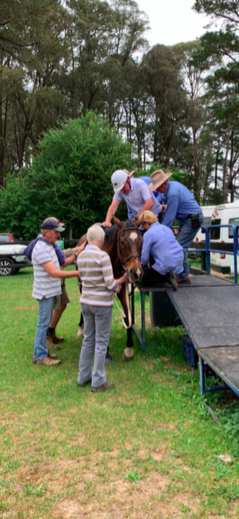
Pictured above: Angus and the volunteers help Neil mount his horse
The sky grew ominously dark and rain started to fall, but nothing was going to put a dampener on the spirits of the volunteers or the riders. After all the riders were in the saddle, the group made their way to the indoor arena to begin their riding lesson. Each rider had one volunteer leading their horse, and another volunteer on the other side to provide additional support. They walked and trotted each way and practiced their steering by weaving through bending poles, before finishing up with a relay and a snail’s race. Sophie, who is learning to ride independently won the relay, and Louise won the snail’s race.
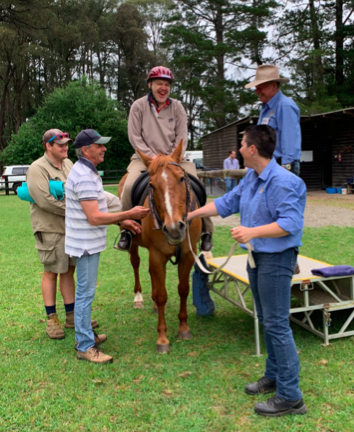
Pictured above: Stephen is thrilled to be back in the saddle and always brings an apple for his horse
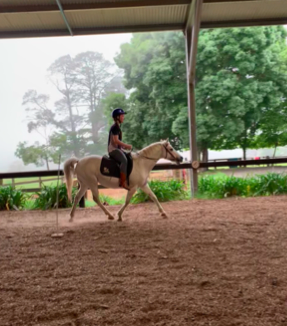
Pictured above: Sophie is learning to ride independently
When Neil, Sophie, Stephen and Louise had finished their lesson, I made my way back to the stables, where a group of younger riders had been given pony rides around the yard. The volunteers were delighted, because Josh had been too afraid to touch horses when he first started coming to RDA, but this week, he proudly smiled for the camera as he gave Benji the pony a big cuddle.
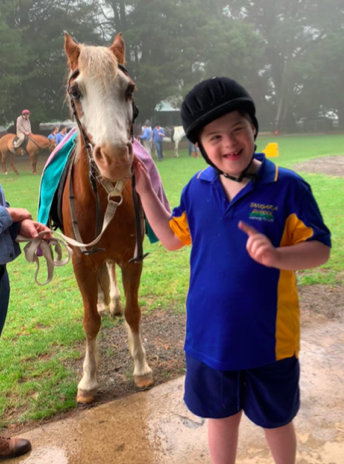
Pictured above: Josh making friends with Benji the pony
As I drove home, I reflected on what had been a truly humbling experience, watching people of all ages and backgrounds, brought together by a shared love of horses, to form a strong and vibrant community. The work that Angus, Neatie and all the volunteers at Riding for the Disabled Moss Vale do, enriches the lives of all the riders and their families, and I urge the community to get involved by volunteering or donating to this amazing organisation.
For more information head to the Riding For the Disabled NSW website at: https://rdansw.org.au/
Pittwater Pharmacy and Compounding Chemist – Not Just a Business but a Community Service
“We do what we do because we care. That’s the whole mission of our profession – to help people…”
– Andrew Snow, co-owner of Pittwater Pharmacy and member of the Papandrea Family
This project is the product of substantial soul-searching and a fortuitous epiphany – after several weeks of melancholy rumination upon my apparent lack of ‘belonging’, initiated by reflection upon the content of this course, I finally realised that I did have connections to a local community. This sense of attachment was discovered whilst enjoying a coffee at a café opposite a building I have known my entire life: Pittwater Pharmacy and Compounding Chemist. The pharmacy is a familiar landmark for the residents of Mona Vale village on Sydney’s Northern Beaches, the area where I spent my childhood before my parents moved back to New Zealand. Having been owned and run by the same Italian family, the Papandreas, for over forty years, the pharmacy boasts an impressively large and loyal clientele, with customers visiting from all over Sydney and even from interstate. Although I have known the Papandrea family since I was a baby, it dawned on me that I actually knew very little about their history. I decided I wanted to know more about this iconic small business and, in the process, create some sort of historical product that would convey how important and integral their work is to the community, both in the past and today. The pharmacy is far more than a business – it is a community service, providing uniquely personable and customised care to each and every one of its customers.
The role that the pharmacy plays in the local community is manifold. Not only do the Papandreas provide free medical and general life advice to members of both the Italian and non-Italian communities of the Northern Beaches, offering this advice to the former in their native tongue, but they also make regular donations to cancer foundations, give free talks on fall prevention, support local sporting events, sponsor the local primary school, donate to the local Catholic church, create hampers full of products that are then donated for events at the Mona Vale Surf Life Saving Club, and both compile and deliver medical Webster packs to clients free of charge. Considering the significant presence that the Papandrea family has in the community and the wide-reaching impact of their generosity, I believed it was important that they received recognition for the work they do. I would like to think that many of the pharmacy’s customers would be interested to learn about the family’s history, particularly about their immigration from Italy to Australia and how they came to open a family-run business in which the members’ ages range from 22 to 72 and where a third generation of Papandrea pharmacists is imminent.
The pharmacy’s clientele primarily consists of middle-aged and elderly customers, many of whom have been served by the Papandreas for several decades and whose children and grandchildren now visit the pharmacy. This demographic informed my decisions regarding the format and presentation of my historical project. In order to engage both younger and older members of the community, I decided to make an information booklet which would be available as both a hard-copy from the pharmacy and as an online PDF, accessed through a link on the pharmacy’s functioning website (URL: https://www.pittwaterpharmacy.com.au/). Moreover, as I wished to focus on the family itself, the majority of the booklet consists of interview excerpts. By providing these intimate glimpses into the Papandreas’ personal history, rather than merely recounting a factual history of the area, I hoped that my intended readers’ engagement with the content would be enhanced considering their individual connections to the family.
s
Given the highly personal nature of the project, the foundation of my research was the collection of oral histories from four members of the Papandrea family and four members of the general public. This was achieved by using my iPhone to record interviews, followed by a combination of manual and assisted online transcription. Although I mainly utilised individual interviews, I also facilitated several group interview settings which were highly beneficial as interviewees were able to supplement each other’s recollections and thereby provide a more complete retelling of the past. The individuals I interviewed were generous with their time, for which I was very grateful; although it has been a challenging undertaking to present these oral histories in a condensed form, it was a privilege to listen to their diverse insights. I have had to be selective with the excerpts used in the booklet – with almost five hours of audio recordings, I initially felt too overwhelmed to commence the transcription and dissemination processes. However, through persistence and determination, I was able to select critical segments that most accurately reflected the Papandreas’ immense generosity and the contributions they have made to the Northern Beaches community.
While the booklet does contain a substantial amount of information, the text has been intentionally interspersed with images, kindly supplied by the Papandrea family. The choice of font and font size was deliberately selected to maximise the booklet’s readability. Furthermore, the booklet’s layout has been designed to not only convey the pharmacy’s historical origins, but to also emphasise the services it provides today. This pro bono work is what makes the pharmacy unique – the level of personalised care that all customers receive, regardless of whether they are a first-time visitor or have been coming to the pharmacy for decades, is hard to find anywhere else. This is particularly pertinent in the contemporary climate where big-chain pharmacies increasingly dominate the pharmaceutical field and threaten to overwhelm small businesses. However, the Papandreas are highly philosophical about this. They know that they will always have to compete with these larger businesses, especially in terms of ‘budget’ pricing, but that will not stop them from providing the exceptional level of individual care they are known and valued for.
Pittwater Pharmacy Website URL: https://www.pittwaterpharmacy.com.au/
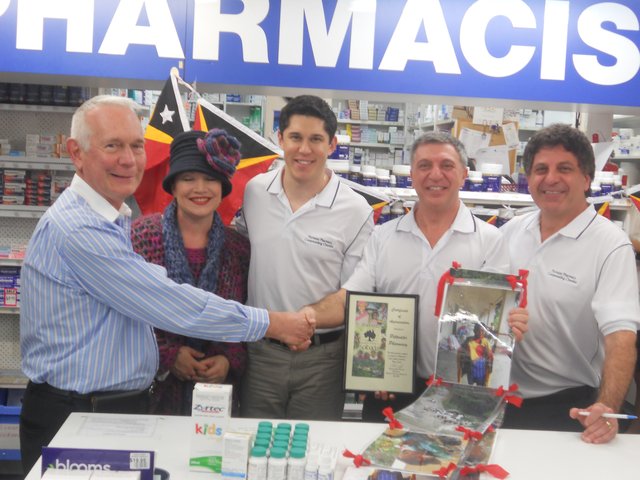
Parliament on King: A counter-narrative
Ravi chops a cheese toastie into several strips and disappears out the back to deliver it to his daughter.
An inner west local takes a beer from the fridge and cracks it open. He looks to pay with his credit card and is gently told that Parliament only takes cash. He is invited to have the beer anyway and bring the cash later.
The barista tells me, “It’s the refugee chefs and the cooks that are working, doing catering or in the café, that have the stories that are important to be told and heard – to create the human interest that will shape policy.”
Parliament on King, a small café at the Erskineville end of King St, breaks down the traditional barriers that exist in the strict separation of home, work and community. In my early visits to Parliament on King, I noticed three dominant narratives that were challenged by this space.
Firstly, Parliament provides a counter narrative to the dominant narrative of separating personal and public space. When I was first welcomed to Parliament, Ravi the owner greeted me as he ran a cheese toastie out the back to his daughter. I experienced for the first time the intersection of personal and public space at Parliament. Growing up in Sydney, I’ve witnessed western home culture that is filled with gated communities, homes encircled by fences, and a clear distinction between those on the inside and those on the outside. There’s an entitlement to personal space, an obsession with having a space that is your own, and a focus on the nuclear family before those beyond. Parliament on King has shown me that this separation of home and work, family and the wider community, is not the only way to live.
Parliament is like a communal living room. There are vibrant conversations and a sense of familiarity amongst strangers. ‘Customers’ pick books off the shelves to discuss the insights pencilled in the margins. A woman in a pink velvet dress is out the front playing a ukulele rendition of Satellite of Love. The café’s windows are open to allow voices to enter, along with the stream of bubbles coming from further up King St. The unplanned sounds, the masses of books, the aroma of coffee and the delivery of toasties to Ravi’s daughter all help to create this sense of home. This is demonstrated at an even deeper level in the way Parliament actively seeks to facilitate a sense of home and belonging for refugees and asylum seekers in Sydney. When I think about my friends and myself—many of whom are in the process of moving out of home for the first time—it makes me wonder how we can reconceptualise ideas of home and community to be more like this.
Secondly, Parliament provides a counter narrative to the dominant narrative of consumer capitalism. The local beer drinker was astounded by the offer to pay later and came rushing back from an ATM up the road fearing he’d forget. The barista at Parliament had turned a clinical transaction into one that built trust and community. He had personalised a depersonalised experience. The customer’s discomfort and confusion with the situation highlights the radically generous and community-oriented posture of Parliament. Again, Parliament was able to demonstrate an alternative to the traditional experience of the customer service industry, which is so quick to turn customers away when money isn’t paid in the moment. In my visits to Parliament on King I have seen numerous customers struggle to find cash to pay their bills – myself included! And each time, I have seen the staff’s consistent trust in the customer’s integrity when they don’t insist on payment then and there – or sometimes even at all. On my first visit, Ravi pointed to the ‘Pay It Forward’ teapot under the passionfruit vine and said, ‘Someone’s already got you covered’.
This counter narrative also manifests itself in Parliament’s rejection of growth and scale as the predominant markers of business or commercial success. At social enterprise conferences, Ravi has engaged in countless discussions about growth and scale of change. Ravi reflected, if Parliament grows to the point that we’re not actually able to sit down, be present, listen and talk with people, what’s the point?
In an interview, the barista at Parliament also commented on scale: “Well, yeah I think it’s a small place changing things for some people. We can only affect the lives of so many people who are working here and who have opportunities. At any single time that’s about ten people. And that’s massive, because you’re changing ten people’s lives.”
I love that. I love that Parliament is not all about scale, growth, expansion and productivity. In the world of social enterprises and social change, Parliament has helped to reorient my understanding of ‘productive’ social change from the quantity of lives changed to the power and beauty of being present and listening to a person, even just one.
And lastly, Parliament provides a counter narrative to the dominant political discourse around asylum seekers. Politicians such as Dutton, Morrison, Abbott and the like, have used their political profiles and platforms to label asylum seekers “illiterate”, “illegal”, “burdens” and “fake”. Amidst these voices, Parliament provides a space in which all people can come and be trusted. Ravi said to me:
“The assumption when you walk in the door here is that you are a good and trustworthy and kind and honourable and decent person, because most of us are . . . If you look at the world and the way it works and the rules that are in place, everything is set up because of our distrust of a small minority. It just makes more sense if the rules were set up because of our faith in the majority.”
Parliament provides a space that affirms all people and counters the narrative of fear and exclusion with acceptance, community and joy. But not only is Parliament on King a welcoming café space, it is also a social enterprise catering organisation that trains asylum seekers in hospitality skills. The work they are doing at Parliament is relationally-focused and counter-cultural. As I attempt to co-construct one part of their public history, I hope that I can represent their stories with the same authenticity they have shown me.
Rugby in Union?
Over the semester I got to work with the Woonona Shamrocks Rugby Club to uncover the club’s history for their 50th anniversary in 2019. I helped out with the club by assisting on a Thursday morning when the older members would mow the field and paint the lines for the coming home game. In this time, I got to interview several members of the club and had the opportunity to be granted access to look through the restricted Illawarra Rugby Union archives which informed me on the early history of the club. Initially, for the project, I aimed to help with writing the book for the 50th anniversary, however, I quickly learned that this task was too large, and I would not be able to complete the book within my timeframe. While continuing to assist in creating the 50th-anniversary book, I decided to create a Wikipedia page for the club, this was a great way for me to contribute to the club in the short term and allowed me to create a digital archive that can be used to assist future researchers whilst also promoting the club. Creating the Wikipedia page and assisting with the 50th anniversary book are all ways in which I assisted in helping the club directly.
The second part of my project does not directly benefit the club but is a way in which I can use all the information I have gathered to present a finished product that not only will promote the Shamrocks but benefit the greater rugby community. I have decided to create a videocast or vodcast. I initially decided to just create a podcast, however, I felt that it would be more engaging if there was a visual element to it. I audio recorded rather than video record the interviews as I felt it was too invasive to video the people being interviewed and wanted to showcase the truest perception of the club that I could capture. The vodcast concentrates on the decline of Australian Rugby, the common argument is that this decline is the cause of the neglect of grassroots rugby. The vodcast uses the Shamrocks 50-year history as a case study on a local scale to highlight issues and changes over time on a national level. The overall message is that clubs are built with social connections, with the neoliberal influence of rugby it is losing this social aspect. The Shamrocks from 50 years ago to now is similar, however at a junior level cracks are starting to appear with one participant stating there will not be a junior rugby club in 10 years. Australian rugby is not dead there is still a pulse at a grassroots level and it is these people that I have spent this semester with that is keeping this pulse to continue beating, not because Australian rugby is helping them but because they are helping each other. And this is not indigenous to the Shamrocks but many clubs around Australia. The way to fix Australian Rugby is for rugby to be in union, meaning that this sense of local community needs to emulate from the grassroots to the Wallabies. The last line of the Shamrock songs encapsulates the motivation of the club to continue the struggle through the decline of Australian rugby, ‘until we hear that bell, that final bell, Shamrocks will fight like hell!’.
Wikipedia – https://en.wikipedia.org/wiki/Woonona_Shamrocks_RUFC
Vodcast – https://youtu.be/OEaGBurEUN4
Chifley High + University of Sydney Essay Competition
On the 26th of October, Bridget Neave and Mike McDonnell attended the annual Chiffley high school humanities award ceremony. The day marks the culmination of a year of hard work for the senior Chiffley students. Students are awarded in areas from business studies, to society and culture, and history. Bridget and Mike were there to award the students for the essays they wrote as part of the University of Sydney’s Essay Writing Competition. This competition has been held jointly by the University and Chiffley High school for the past 5 years.
When it was time for the history awards, Mike was invited to give a talk to the gathered students, teachers and parents on the merits of tertiary education for people of all walks of life. Following this, the highly commended and best essays were awarded. The essays were judged by a number of the history staff including James Tan and Frances Clarke. This years lucky winners were Holly Towner and Grace Major. After, Bridget gave feedback and commendation on two high achieving Personal Interest Projects (the society and culture major work). Which were of an impeccable standard this year.
Following the ceremony, the students, parents, teachers and guests enjoyed a pizza lunch together. Discussing the future plans of the year twelve students. Lucky for us, many of them plan to go to the University of Sydney next year.
The social inclusion program looks forward to working with Chiffley college again in 2019!

Rule of Law – Project Rationale
When I began this project at the start of the semester, I was a little lost as to what I was going to do and who I was going to work with. Having only moved to Sydney this year from Western Australia and not knowing any non-for-profit or community organisations I was quickly extremely concerned with how I was going to progress with this course. After doing some research, which included a lot of googling ‘non-for-profit organisations Sydney,’ I stumbled across the Rule of Law Institute, an organisation I knew nothing about. I didn’t know whether they needed any help, let alone what my project would be should they consent to my volunteering for their organisation.
This project provided myself with an invaluable experience. The Rule of Law Institute of Australia serves a vital and important role in promoting civic education and an understanding of the rule of law for the youth of Australia. My project was based on providing the Rule of Law Institute with my most valuable asset, and the asset they lacked, time. The few staff at the Rule of Law Institute are too busy to be able to take time out of their days to focus on reading multiple articles, reports, periodicals and laws. I filled this void and did the research that was necessary for those working at the Rule of Law Institute to write an article for the journal LexisNexis.
The research project I embarked on was focussed on gathering the background information on the state of the rule of law in Hungary, Poland, the Philippines and Australia. Although this project was extremely conventional in an academic context and lacked the creativity of some of the other projects, it provided me with the skills necessary to work in a research institution or think tank in both Australia and beyond. To know that the research I compiled on the rule of law was going to serve a purpose in an academic journal was extremely fulfilling, Furthermore, before embarking upon the research I first had to learn about the rule of law itself, what it is, where it comes from, what constitutes it.
The significance of this project is where its importance is realized. Firstly, the project allowed for the Rule of Law Institute to continue focussing their work on their civic education projects and to continue spreading the rule of law. Secondly, the project will directly contribute to the understanding of the state of the rule of law globally, something that is in crisis. This project will allow for continued intellectual debate and has directly contributed to the development of the scholarship on the rule of law. Finally, and most importantly, it serves a purpose of delving into the role of the rule of law in Australia and how the Institute can mould its education and lobbying to those areas that need most attention within Australia. In my research, I found that there is an immense amount of complacency towards the rule of law in Australia, and this leaves the Australian public open to rights violations and exploitation by the government and our legal system. There appears to be a great need for rule of law academic work in Australia given this complacency, as it is only through academic work that support for the Rule of Law Institute can be developed and grow. Through my contribution to this journal article, hopefully this will be addressed in some regard, especially given the focus I placed on the anti-terror legislation that is extremely dangerous to the Australian public.
My research project has been extremely valuable, to my own personal growth as a junior historian, to the development of the rule of law in Australia, and to the Rule of Law Institute. Most importantly, it has been a tremendous and valuable learning experience, both in the information I learnt about the state of the rule of law but also in the opportunities there are beyond the realm of academia for historians.
I encourage anyone reading this to read about the Rule of Law Institute and all the vital work they do.
